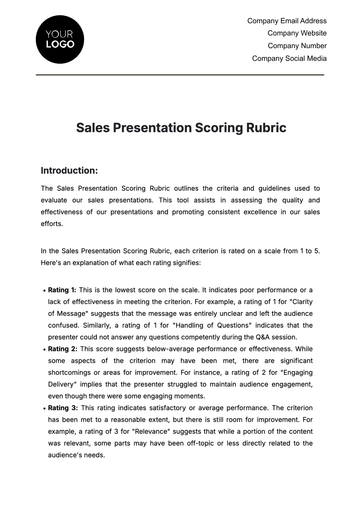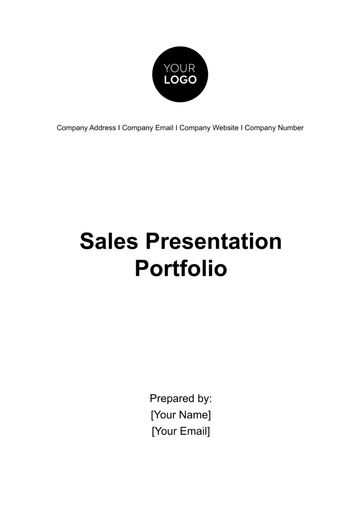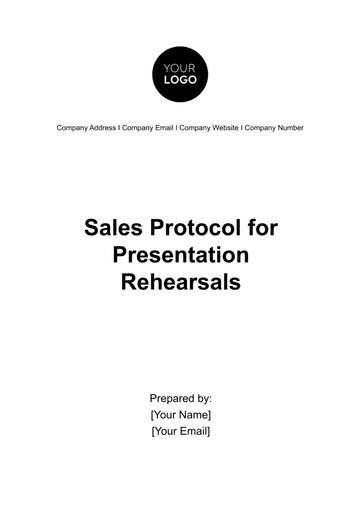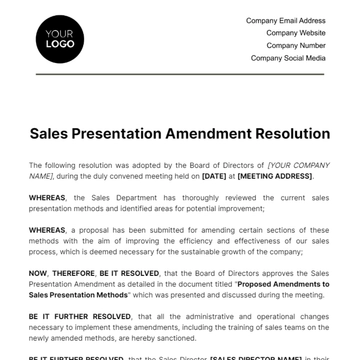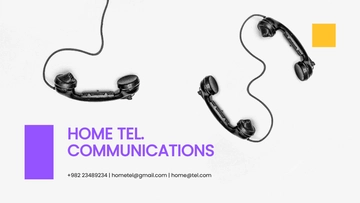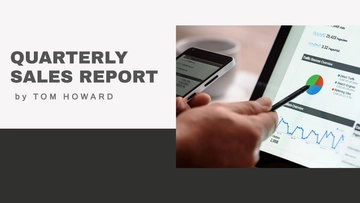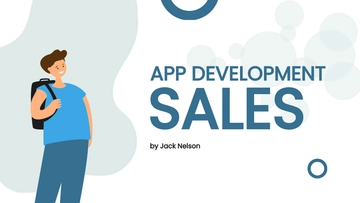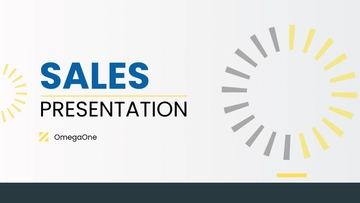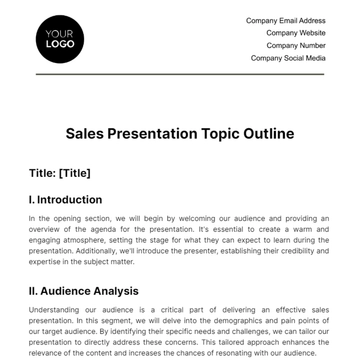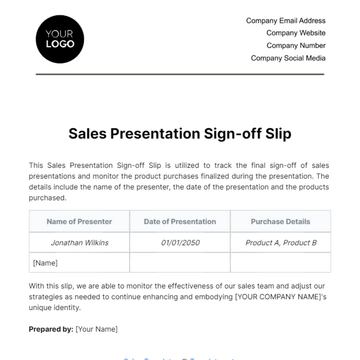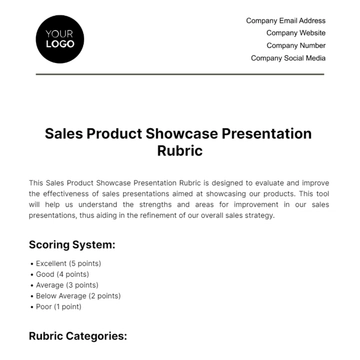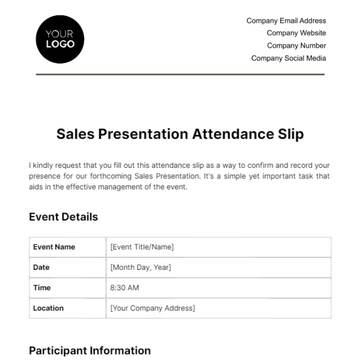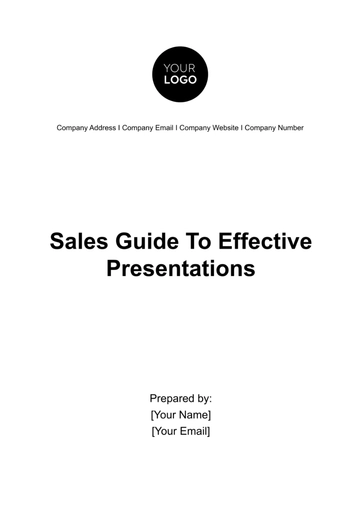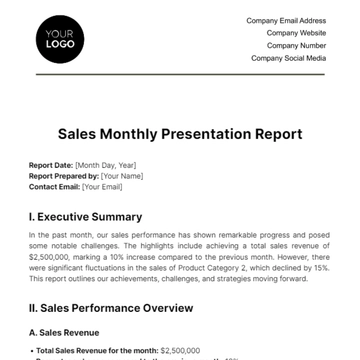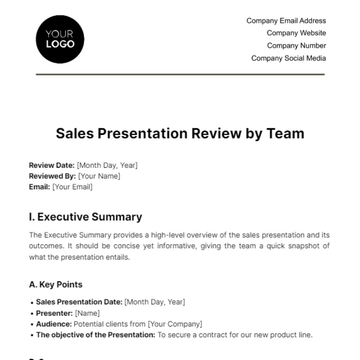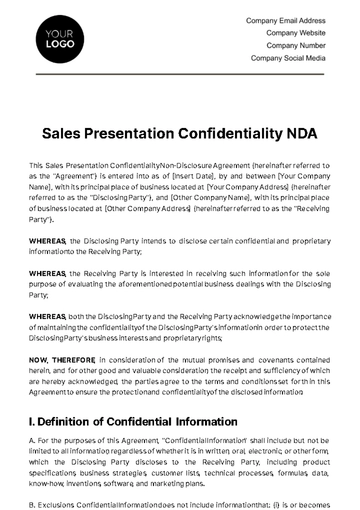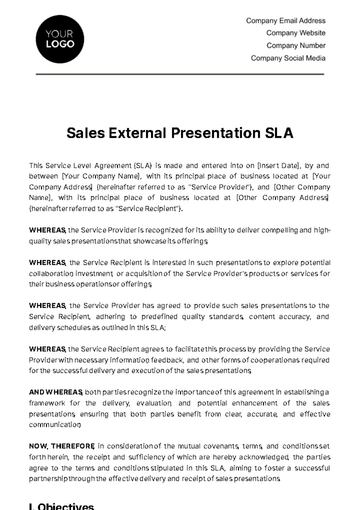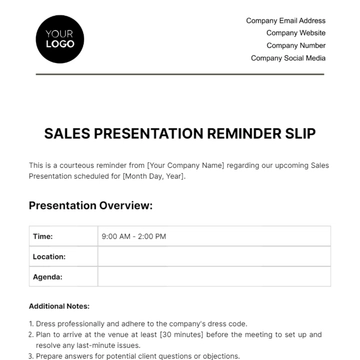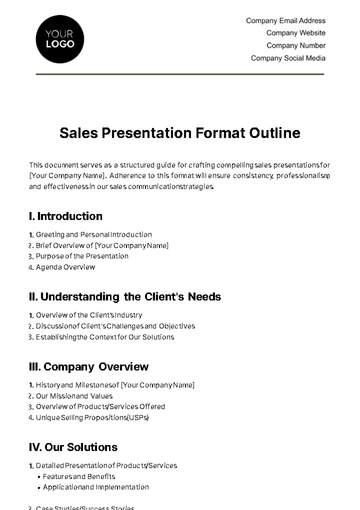Free Sales Presentation Best Practices User Guide
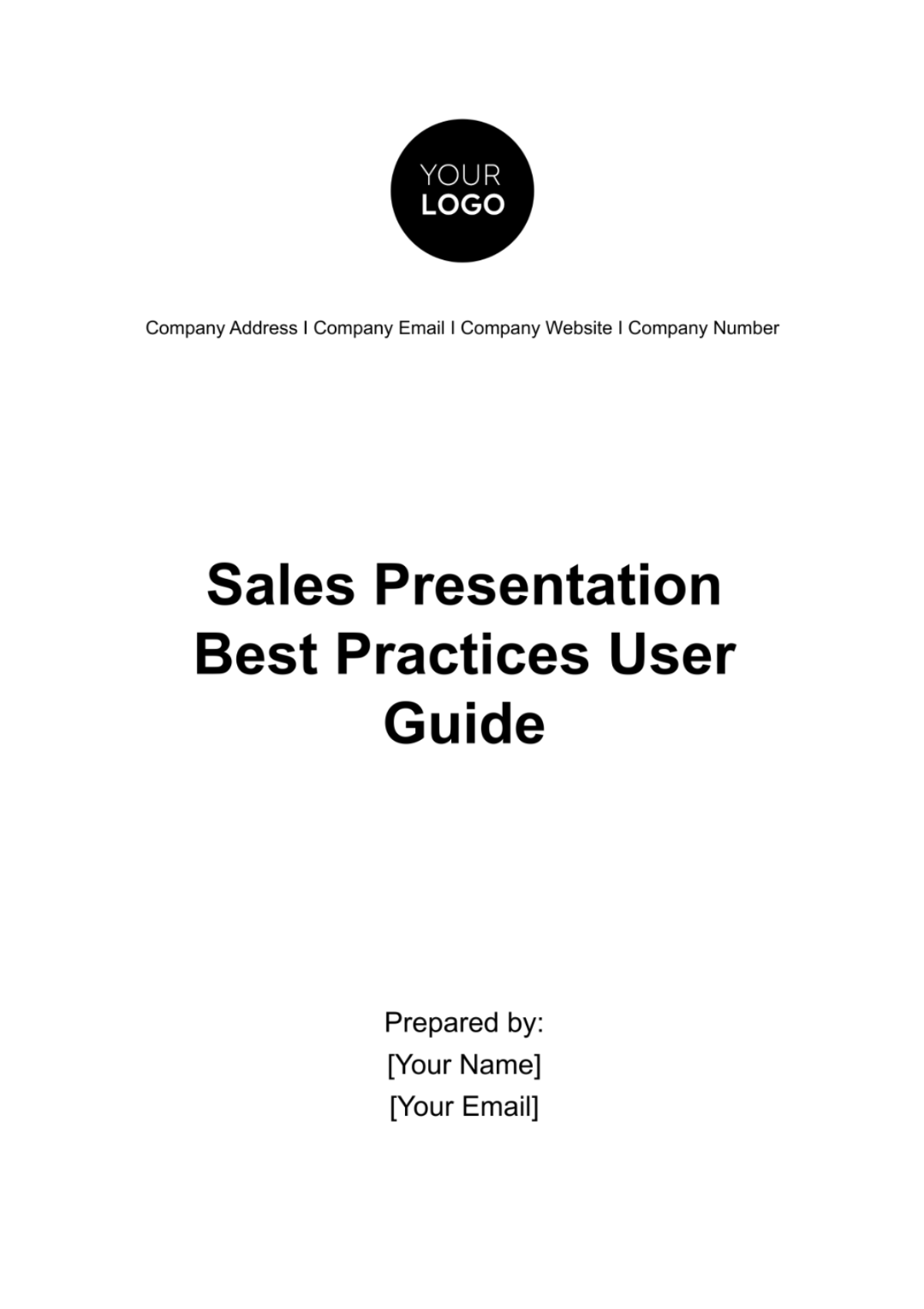
Introduction
In the dynamic world of sales, presentations serve as your canvas, where you paint the picture of your products or services in the most compelling and irresistible way. Whether you're aiming to win over a potential client, secure a partnership, or close a deal, your presentation is the bridge that connects your offerings to the needs and desires of your audience.
This Sales Presentation Best Practices User Guide is your gateway to unlocking the secrets of successful sales presentations. It is here to guide you through the intricacies of the art of persuasion, equipping you with the tools, techniques, and insights you need to stand out in the competitive landscape of sales.
Why Best Practices Matter
In a world saturated with information, making a lasting impression and driving conversions can be an uphill battle. This guide underscores the importance of embracing best practices in your sales presentations. It's not merely about following a set of rules but rather about elevating your craft to an art form. When done right, a sales presentation isn't just a pitch; it's a captivating story that engages, inspires, and ultimately persuades.
By adopting the best practices outlined in this guide, you're not only ensuring that your audience understands the value you bring but also instilling in them the confidence to say "yes." So, let's dive into the world of sales presentations, where the extraordinary becomes the ordinary, and where you emerge as a true master of the art of persuasion.
Understanding Your Audience
In this section, we'll equip you with the skills and insights to turn your audience from passive spectators into engaged participants. By mastering the art of audience understanding, you'll create presentations that resonate, persuade, and ultimately drive your sales success.
Creating Rich Buyer Personas:
Your sales presentation's success hinges on knowing who you're presenting to. In this section, you'll learn how to create comprehensive buyer personas. Dive deep into the minds and motivations of your potential clients, uncovering their pain points, desires, and expectations. By understanding your audience at a profound level, you'll be better equipped to tailor your presentation to resonate with their needs.
Tailoring Your Message With Precision:
Tailoring isn't just about customization; it's about precision. Discover how to craft a message that speaks directly to the hearts and minds of your prospects. We'll explore techniques for aligning your presentation with your audience's unique interests and challenges, ensuring that they not only listen but also engage and connect with your message.
The Power Of Empathy:
One of the most potent tools in your sales arsenal is empathy. Learn how to step into your audience's shoes, see the world from their perspective, and use this profound understanding to forge genuine connections. Empathy is the secret sauce that turns an ordinary presentation into an extraordinary one.
Feedback Loop For Continuous Improvement:
Understanding your audience is an ongoing process. We'll show you how to establish a feedback loop that allows you to gather insights, adapt your approach, and continually refine your presentations. In this dynamic landscape, you'll always be one step ahead, ensuring your audience feels heard and valued.
Structure And Content
Your sales presentation's structure and content form the backbone of your pitch. Creating a well-organized and engaging presentation can make all the difference in capturing your audience's attention and driving your message home. Here's a comprehensive breakdown of this crucial section:
Section | Description |
|---|---|
Introduction | Crafting a captivating opening to grab your audience's interest. |
Setting the tone and context for your presentation. | |
Establishing a clear purpose and a compelling "hook." | |
Body | Developing the core content that delivers your key message |
The power of storytelling to connect with your audience emotionally. | |
Structuring your message using a problem-solving framework. | |
Building a persuasive narrative that leads to your solution. | |
Supporting your claims with data, testimonials, and case studies. | |
Closing | Summarizing your key points and reinforcing your value proposition. |
Using a strong closing statement to leave a lasting impression. | |
Providing a clear call to action and outlining the next steps. |
The table above breaks down the Structure and Content section into three key parts: Introduction, Body, and Closing. Each part plays a crucial role in your sales presentation's success.
By following these guidelines and carefully structuring your content, you'll be well on your way to delivering a compelling and persuasive presentation that resonates with your audience.
Visual Aids
In the realm of sales presentations, the adage "a picture is worth a thousand words" couldn't be truer. Visual aids can be the difference between a forgettable pitch and a memorable, persuasive presentation. In this section, we'll delve into the art of visual storytelling, offering techniques and strategies to make your visuals stand out and leave a lasting impression.
Designing Engaging Slides:
The Science Of Slide Design | Discover the psychology behind slide layouts, colors, and fonts that capture attention. |
Crafting A Visual Narrative | Turn your slides into a compelling story that complements your spoken words. |
Effective Use Of Images | Harness the power of images to evoke emotions and convey complex ideas. |
Data Visualization And Charts:
Making Data Accessible | Transform data into a visual format that everyone can understand. |
Choosing The Right Chart | Learn which chart types are best suited for different data and messages. |
Storytelling With Data | Weave data into your narrative to build a stronger case. |
Incorporating Multimedia
Engaging With Video | Incorporate video clips for product demonstrations, testimonials, and engagement. |
Live Demos And Interactive Tools | Bring interactivity to your presentation through live demonstrations and interactive applications. |
Augmented Reality (AR) And Virtual Reality (VR) | Explore cutting-edge technologies to immerse your audience in your offerings. |
These are the tools and insights needed to create visually stunning and highly persuasive presentations. Engage your audience on a whole new level, leaving a profound impact with your visual aids.
Engagement Techniques
Your ability to engage your audience is the cornerstone of a successful sales presentation. In this section, we'll delve into a range of powerful techniques that will keep your audience hanging on your every word and, more importantly, eager to act on your recommendations.
Asking Powerful Questions
Learn how to ask thought-provoking questions that ignite curiosity and drive meaningful conversations. Craft questions that unearth your prospect's pain points and goals, paving the way for tailored solutions.
Interactive Elements And Demonstrations
Turn passive listeners into active participants with interactive elements. Discover how to use live demonstrations, simulations, and hands-on experiences to create lasting impressions and solidify your message.
Fostering Two-Way Communication
Uncover the art of genuine engagement through dialogue. We'll explore techniques for listening actively, responding empathetically, and building rapport. Transform your presentations into dynamic conversations that leave a lasting impact.
Handling Objections
Objections are a natural part of the sales process. By mastering the art of handling objections, you can transform resistance into collaboration and move one step closer to sealing the deal.
Turning Challenges Into Opportunities
Handling objections effectively is a crucial aspect of a successful sales presentation. Objections are not roadblocks; they are opportunities to address concerns and build trust. This section equips you with the tools and strategies to navigate objections with finesse, turning skepticism into a "yes."
Common Objections And How To Address Them
Discover the most common objections that sales professionals encounter and learn proactive ways to address them head-on. We provide practical scripts and responses that will help you handle objections confidently.
Building Trust And Credibility
Understand how objections can be an opportunity to reinforce your credibility and trustworthiness. Discover techniques to instill confidence in your audience and turn objections into a reason to buy.
Customization
Incorporating the principles outlined in this section will set you on the path to delivering presentations that feel like they were created exclusively for each prospect. Embrace the power of customization, and watch as your conversion rates soar.
Crafting Personalized Solutions
In the realm of sales presentations, one size does not fit all. Customization is the key to resonating with your audience and demonstrating that you understand their unique needs and challenges. This section delves into the art of crafting personalized solutions that leave a lasting impression and inspire confidence in your offerings.
Personalizing Your Presentation:
Unveiling The Power Of Personalization | Understand the impact of addressing your prospect by name and other personalized touchpoints. |
Tailoring Your Content | Learn how to modify your presentation to align with the specific needs, goals, and pain points of your audience. |
Connecting On A Human Level | Discover strategies for building rapport and trust through personal anecdotes and shared experiences. |
Demonstrating Unique Value:
The Value Proposition Reimagined | Transform your value proposition to showcase what makes your product or service unique. |
Highlighting Benefits And Features | Understand how to spotlight the features and benefits that matter most to your prospects. |
Case Studies And Success Stories | Leverage real-world examples that resonate with your audience's industry, challenges, and goals. |
Use Of Data And Statistics
In the digital age, data and statistics have become invaluable allies in crafting persuasive sales presentations. Your ability to incorporate data-driven insights and compelling statistics can substantially boost your credibility and influence your audience's decision-making. In this section, we'll explore the art of harnessing data and statistics effectively.
Leveraging Data To Tell Your Story:
Learn how to use data as a compelling narrative tool. We'll guide you on transforming raw numbers into compelling stories that resonate with your audience's needs and aspirations.
Building Credibility Through Numbers:
Discover the science of building trust and credibility through well-sourced statistics. We'll provide you with strategies to ensure your data is accurate, relevant, and trustworthy.
Visualizing Data:
Turn complex data sets into clear and engaging visuals. We'll discuss the power of infographics, charts, and graphs to simplify complex information and make it accessible to your audience.
Using Data To Address Pain Points:
Understand how data can be used to address specific pain points or challenges your audience faces. We'll show you how to tailor your data presentation to offer solutions that resonate.
Real-World Applications:
Explore real-world case studies and examples of how data-driven presentations have led to sales success. By seeing the practical applications of data and statistics, you'll gain insights into how to apply these techniques in your own presentations.
Mastering the use of data and statistics in your sales presentations can set you apart from the competition. It's not just about numbers; it's about using those numbers to tell a compelling story and provide your audience with the confidence to make informed decisions.
Delivery And Confidence
Delivering your sales presentation with confidence is key to persuading your audience and sealing the deal. In this section, you will learn the essential skills and techniques for confident delivery, ensuring your message resonates and captivates your prospects. We cover:
Body Language:
This is an essential component of effective communication, particularly in the realm of sales presentations. Mastery of body language involves the strategic use of these cues to reinforce the spoken word, thereby exuding an aura of trustworthiness, credibility, and enthusiasm. Key aspects include:
Posture and Presence: Adopting a confident stance, with shoulders back and head held high, projects confidence and engages the audience.
Gestures: Purposeful gestures can emphasize key points and aid in the visualization of your message, making it more memorable.
Facial Expressions: Aligning your facial expressions with your content can significantly enhance the emotional connection with your audience.
Eye Contact: Establishing direct eye contact fosters a sense of engagement and trust, making your audience feel valued and listened to.
Nervousness Management: Nervousness in high-stakes presentation scenarios is a common challenge that can hinder the effectiveness of your delivery. Managing this nervousness is critical for maintaining poise and ensuring that your message is delivered clearly and confidently. Techniques for nervousness management include:
Preparation and Practice: Familiarity with your material can significantly reduce anxiety. Thorough preparation and repeated practice of your presentation can instill a sense of confidence.
Breathing Exercises: Deep, controlled breathing can help calm the nervous system and reduce physical symptoms of nervousness.
Positive Visualization: Envisioning a successful presentation outcome can boost confidence levels and reduce pre-presentation anxiety.
Grounding Techniques: Simple physical actions, such as grounding your feet or gently squeezing your hands, can help maintain focus and composure.
Clear And Convincing Speech: The ability to articulate your message clearly and persuasively is fundamental to the success of any sales presentation. Clear articulation ensures that your message is easily understood, while persuasive techniques are essential for influencing your audience's perceptions and decisions. Key strategies include:
Clarity of Speech: Speaking clearly and at a measured pace aids in the comprehension of your message. Avoiding jargon and using simple, concise language can make your presentation accessible to a wider audience.
Emotional Appeal: Connecting your message to the emotions or personal experiences of your audience can greatly enhance persuasion. This involves understanding your audience's needs and tailoring your message accordingly.
Evidence and Credibility: Supporting your arguments with data, testimonials, or case studies can bolster your credibility and persuade skeptically minded individuals.
Call to Action: Clearly articulating what you want your audience to do after your presentation is critical for driving outcomes. A compelling call to action can motivate your audience to take the desired step.
Follow-Up And Next Steps
Your presentation was a success; the prospect is engaged and interested. Now, what's next? The Follow-Up And Next Steps section will guide you through the critical post-presentation phase:
Effective Post-Presentation Follow-Up: Learn how to keep the momentum going after your presentation. Discover best practices for sending follow-up emails, scheduling meetings, and maintaining open lines of communication.
Closing The Sale With Confidence: Delve into the art of closing deals. Whether it's asking for the sale or guiding your prospect towards a decision, this section provides strategies to ensure a confident and successful close.
Handling Questions And Concerns: Sometimes, questions and concerns arise after the presentation. Understand how to address these in a way that reassures your prospect and paves the way for a positive resolution.
This section equips you with the skills to not only secure the deal but also establish long-lasting relationships with your clients. It's where the seeds of trust and partnership are sown.
Conclusions
The Sales Presentation Best Practices User Guide serves as an essential resource for sales professionals seeking to optimize their presentation skills and strategies. By implementing the guidelines and techniques presented in this guide, individuals can significantly improve their ability to engage with prospects, convey compelling value propositions, and drive successful outcomes.
- 100% Customizable, free editor
- Access 1 Million+ Templates, photo’s & graphics
- Download or share as a template
- Click and replace photos, graphics, text, backgrounds
- Resize, crop, AI write & more
- Access advanced editor
Master the art of sales presentations with Template.net's Sales Presentation Best Practices User Guide Template. Crafted for professionals, this editable and customizable guide shares industry secrets and best practices. Edit effortlessly in our Ai Editor Tool, empowering users to develop engaging, result-driven sales presentations.
You may also like
- Aesthetic Presentation
- Presentation Background
- Slide Show Presentation
- Cute Presentation
- Education Presentation
- Border Frames Presentation
- Teacher Presentation
- Professional Presentation
- Timeline Presentation
- Brand Presentation
- Promotion Presentation
- Business Presentation
- Event Presentation
- Company Presentation
- Startup Presentation
- University Presentation
- Food Presentation
- Music Presentation
- School Presentation
- Art Presentation
- Marketing Presentation
- Business Plan Presentation
- Mobile Presentations
- Freelancer Presentation
- Project Presentation
- Agency Presentation
- Sales Presentation
- HR Presentation
- Product Presentation
- Roadmap Presentation
- Slideshow
- Technology Presentation
- Real Estate Presentation
- Medical Presentation
- Speaker Presentation
- Construction Presentation
- Conference Presentation
- Restaurant Presentation
- IT and Software Presentation
- Portfolio Presentation
- Campaign Presentation
- Game Presentation
- History Presentation
- Math Presentation
- Lesson Presentation
- Health Presentation
- Graduation Presentation
- New Year's Day Presentation
- Social Studies Presentation
- Photography Presentation
- Social Media Presentation
- Valentine's Day Presentation
- Services Presentation
- Workshop Presentation
- Organization Presentation


